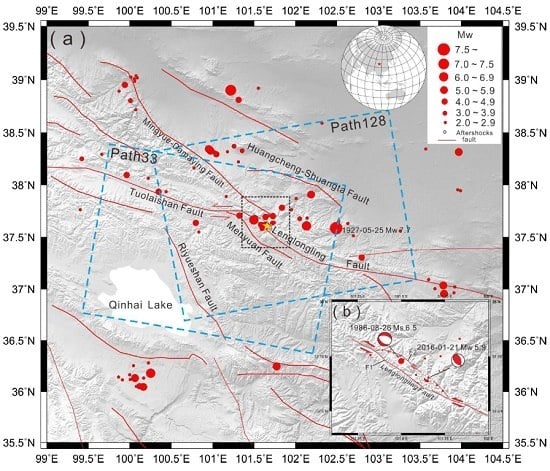Space Geodetic Observations and Modeling of 2016 Mw 5.9 Menyuan Earthquake: Implications on Seismogenic Tectonic Motion
Abstract
:1. Introduction
2. Tectonic Settings
3. InSAR Coseismic Measurements and Geodetic modeling
3.1. InSAR Coseismic Deformation
3.2. Geodetic Modeling for Earthquake Rupture
4. Discussion
4.1. Lateral Variation of the Motion along the Lenglongling Fault
4.2. Regional Active Tectonic Features Inferred from Two Earthquakes
5. Conclusions
Acknowledgments
Author Contributions
Conflicts of Interest
References
- U.S. Geological Survey (USGS). Available online: http://earthquake.usgs.gov/earthquakes/search/ (accessed on 16 June 2016).
- Global Centroid Moment Tensor Catalogue (GCMT). Available online: http://www.globalcmt.org/CMTsearch.html (accessed on 16 June 2016).
- Gaudemer, Y.; Tapponnier, P.; Meyer, B.; Peltzer, G.; Shunmin, G.; Zhitai, C.; Huagung, D.; Cifuentes, I. Partitioning of crustal slip between linked, active faults in the eastern Qilian Shan, and evidence for a major seismic gap, the ‘Tianzhu gap’, on the western Haiyuan Fault, Gansu (China). Geophys. J. Int. 1995, 120, 599–645. [Google Scholar] [CrossRef]
- Xu, J.; Yao, L.; Wang, J. Earthquake source mechanisms of Menyuan Earthquake (Ms = 6.4, on 26 August 1986) and its strong aftershocks. Northwest. Seismol. J. 1986, 8, 84–86. [Google Scholar]
- Liu, J.; Ji, C.; Zhang, J.Y.; Zhang, P.Z.; Zeng, L.S.; Li, Z.F.; Wang, W. Tectonic setting and general features of coseismic rupture of the 25 April 2015 Mw 7.8 Gorkha, Nepal earthquake. Chin. Sci. Bull. 2015, 60, 2640–2655. (In Chinese) [Google Scholar] [CrossRef]
- England, P.; Houseman, G. Finite strain calculations of continental deformation: 2. Comparison with the India-Asia collision zone. J. Geophys. Res. 1986, 91, 3664–3676. [Google Scholar] [CrossRef]
- England, P.; McKenzie, D. A thin viscous sheet model for continental deformation. Geophys. J. Int. 1982, 70, 295–321. [Google Scholar] [CrossRef]
- Dewey, J.F.; Shackleton, R.M.; Chang, C.; Yiyin, S. The tectonic evolution of the Tibetan Plateau. Philos. Trans. R. Soc. Lond. Ser. A Math. Phys. Sci. 1988, 327, 379–413. [Google Scholar] [CrossRef]
- Tapponnier, P.; Shu, Z.; Roger, F.; Meyer, B.; Arnaud, N.; Wittlinger, G.; Jingsui, Y. Oblique stepwise rise and growth of the Tibet Plateau. Science 2011, 294, 1671–1677. [Google Scholar] [CrossRef] [PubMed]
- Staisch, L.M.; Niemi, N.A.; Clark, M.K.; Chang, H. Eocene to late Oligocene history of crustal shortening within the Hoh Xil Basin and implications for the uplift history of the northern Tibetan Plateau. Tectonics 2016, 35. [Google Scholar] [CrossRef]
- Wang, S.; Zhang, X.; Zhang, S.; Zhang, X.; Xue, F. Characteristics of recent tectonic deformation and seismic activity in the northeastern margin of Tibetan Plateau. Acta Geosci. Sin. 2005, 26, 209–216. [Google Scholar]
- Yuan, D.Y.; Zhang, P.Z.; Liu, B. Geometrical imagery and tectonic transformation of the late Quaternay active tectonics in northeast margin of Qinghai-Xizang plateau. Acta Geol. Sin. 2004, 78, 270–278. (In Chinese) [Google Scholar]
- Zheng, W.; Zhang, P.; He, W. Transformation of displacement between strike-slip and crustal shortening in the northern margin of the Tibetan plateau: Evidence from decadal GPS measurements and late Quaternary slip rates on faults. Tectonophysics 2013, 584, 267–280. [Google Scholar] [CrossRef]
- Liang, S.; Gan, W.; Shen, C.; Xiao, G.; Liu, J.; Chen, W.; Ding, X.; Zhou, D. Three-dimensional velocity field of present-day crustal motion of the Tibetan Plateau derived from GPS measurements. J. Geophys. Res. Solid Earth 2013, 118, 5722–5732. [Google Scholar] [CrossRef]
- Gan, W.; Zhang, P.; Shen, Z.-K.; Niu, Z.; Wang, M.; Wan, Y.; Zhou, D.; Cheng, J. Present-day crustal motion within the Tibetan Plateau inferred from GPS measurements. J. Geophys. Res. 2007, 112, B08416. [Google Scholar] [CrossRef]
- Lasserre, C.; Gaudemer, Y.; Tapponnier, P.; Mériaux, A.-S.; van der Woerd, J.; Daoyang, Y.; Ryerson, F.J.; Finkel, R.C.; Caffee, M.W. Fast late Pleistocene slip rate on the Leng Long Ling segment of the Haiyuan fault, Qinghai, China. J. Geophys. Res. 2002, 107, 2276. [Google Scholar] [CrossRef]
- He, W.; Liu, B.; Yuan, D.; Yang, M. Research on the slip rate of the Lenglongling fault zone. Northwest. Seismol. J. 2000, 22, 90–97. (In Chinese) [Google Scholar]
- He, W.; Yuan, D.; Ge, W.; Luo, H. Determination of the slip rate of the Lenglongling fault in the middle and eastern segments of the Qilian mountain active fault zone. Earthquake 2010, 30, 131–137. (In Chinese) [Google Scholar]
- Li, Q.; Jiang, Z.; Wu, Y. Present-day tectonic deformation characteristics of Haiyuan-Liupanshan Fault Zone. J. Geodesy Geodyn. 2013, 33, 18–22. [Google Scholar]
- Wegmüller, U.; Werner, C.; Strozzi, T.; Wiesmann, A.; Frey, O.; Santoro, M. Sentinel- 1 a support in the GAMMA software. In Proceedings of the Fringe 2015 Conference, ESA ESRIN, Frascati, Italy, 23–27 March 2015.
- Goldstein, R.M.; Werner, C.L. Radar interferogram filtering for geophysical applications. Geophys. Res. Lett. 1995, 25, 4035–4038. [Google Scholar] [CrossRef]
- Chen, C.W. Statistical-Cost Network-Flow Approaches to Two-Dimensional Phase Unwrapping for Radar Interferometry. Ph.D. Thesis, Stanford University, Stanford, CA, USA, 2001. [Google Scholar]
- Copley, A.; Karasozen, E.; Oveisi, B.; Elliott, J.R.; Samsonov, S.; Nissen, E. Seismogenic faulting of the sedimentary sequence and laterally variable material properties in the Zagros Mountains (Iran) revealed by the August 2014 Murmuri (E. Dehloran) earthquake sequence. Geophys. J. Int. 2015, 203, 1436–1459. [Google Scholar] [CrossRef]
- Solaro, G.; De Novellis, V.; Castaldo, R.; De Luca, C.; Lanari, R.; Manunta, M.; Casu, F. Coseismic fault model of Mw 8.3 2015 Illapel Earthquake (Chile) retrieved from multi-orbit Sentinel1-A DInSAR measurements. Remote Sens. 2016, 8, 323. [Google Scholar] [CrossRef]
- Feng, W.; Li, Z.; Hoey, T.; Zhang, Y.; Wang, R.; Samsonov, S.; Li, Y.; Xu, Z. Patterns and mechanisms of coseismic and postseismic slips of the 2011 M W 7.1 Van (Turkey) earthquake revealed by multi-platform synthetic aperture radar interferometry. Tectonophysics 2014, 632, 188–198. [Google Scholar] [CrossRef]
- Feng, W.; Lindsey, E.; Barbot, S.; Samsonov, S.; Dai, K.; Li, P.; Li, Z.; Almeida, R.; Chen, J.; Xu, X. Source characteristics of the 2015 M W 7.8 Gorkha (Nepal) earthquake and its M W 7.2 aftershock from space geodesy. Tectonophysics 2016. [Google Scholar] [CrossRef]
- Okada, Y. Surface deformation due to shear and tensile faults in a half-space. Bull. Seismol. Soc. Amer. 1985, 75, 1135–1154. [Google Scholar]
- Harris, R.A.; Segall, P. Detection of a locked zone at depth on the Parkfield, California, segment of the San Andreas fault. J. Geophys. Res. 1987, 92, 7945–7962. [Google Scholar] [CrossRef]
- Bürgmann, R.; Ayhan, M.E.; Fielding, E.J.; Wright, T.J.; McClusky, S.; Aktug, B.; Demir, C.; Lenk, O.; Türkezer, A. Deformation during the 12 November 1999 Düzce, Turkey, earthquake, from GPS and InSAR data. Bull. Seismol. Soc. Am. 2002, 92, 161–171. [Google Scholar] [CrossRef]
- Sreejith, K.M.; Sunil, P.S.; Agrawal, R.; Saji, A.P.; Ramesh, D.S.; Rajawat, A.S. Coseismic and early postseismic deformation due to the 25 April 2015, Mw 7.8 Gorkha, Nepal, earthquake from InSAR and GPS measurements. Geophys. Res. Lett. 2016, 43. [Google Scholar] [CrossRef]
- Fang, L.; Wu, J.; Wang, W. Relocation of mainshock and aftershock sequences of Ms7.0 Sichuan Lushan earthquake. Chin. Sci. Bull. 2013, 58, 1901–1909. [Google Scholar] [CrossRef]
- Zhao, W.; Mechie, J.; Feng, M.; Si, D.; Xue, G.; Su, H.; Song, Y.; Yang, H.; Liu, Z. Cenozoic orogenesis of the Qilian Mountain and the lithosphere mantle tectonic framework beneath it. Geol. China 2014, 41, 1411–1423. (In Chinese) [Google Scholar]
- Taylor, M.; Yin, A. Active structures of the Himalayan-Tibetan orogen and their relationships to earthquake distribution, contemporary strain field, and Cenozoic volcanism. Geosphere 2009, 5, 199–214. [Google Scholar] [CrossRef]
- Wang, J.; Qin, B.; Dang, Q. A study on the fracture process of the Menyuan M6.4 earthquake occurred on 26 August 1986. North China Earthq. Sci. 1992, 10, 25–33. [Google Scholar]
- Li, Y.; Liu, X. Activity analysis of faults around Qilianshan before the 2016 Menyuan Ms6.4 earthquake. J. Geodesy Geodyn. 2016, 36, 288–293. [Google Scholar]
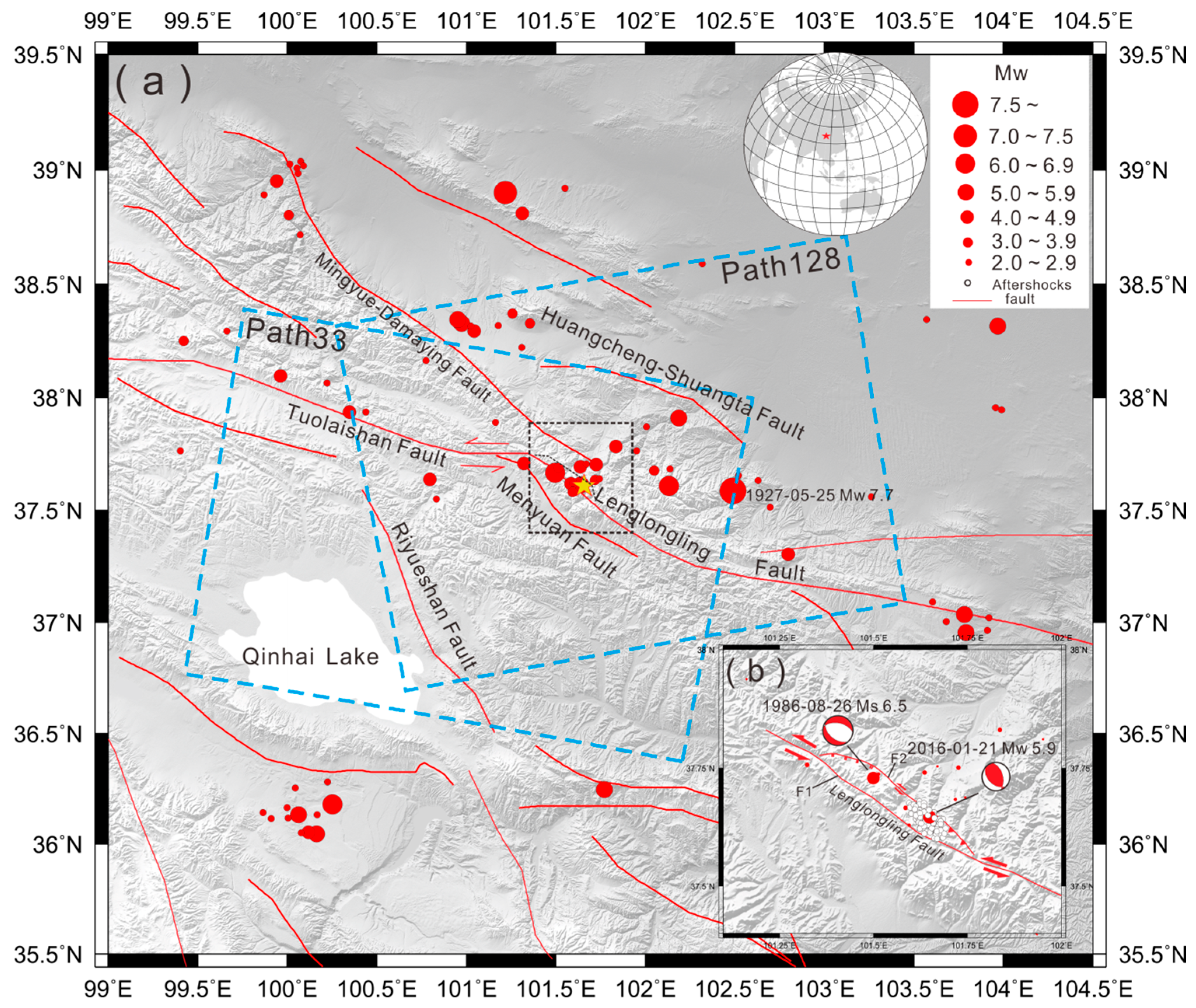
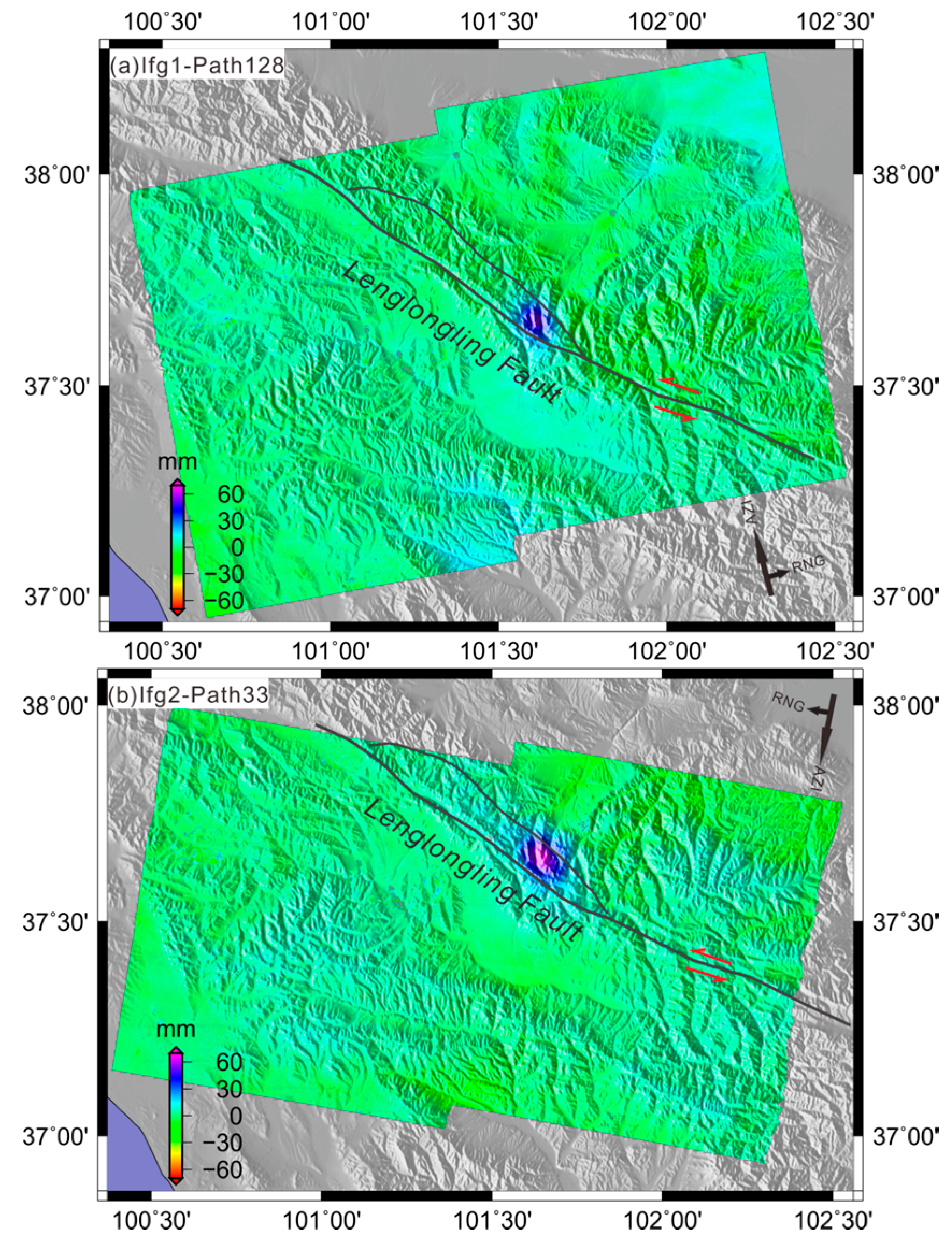
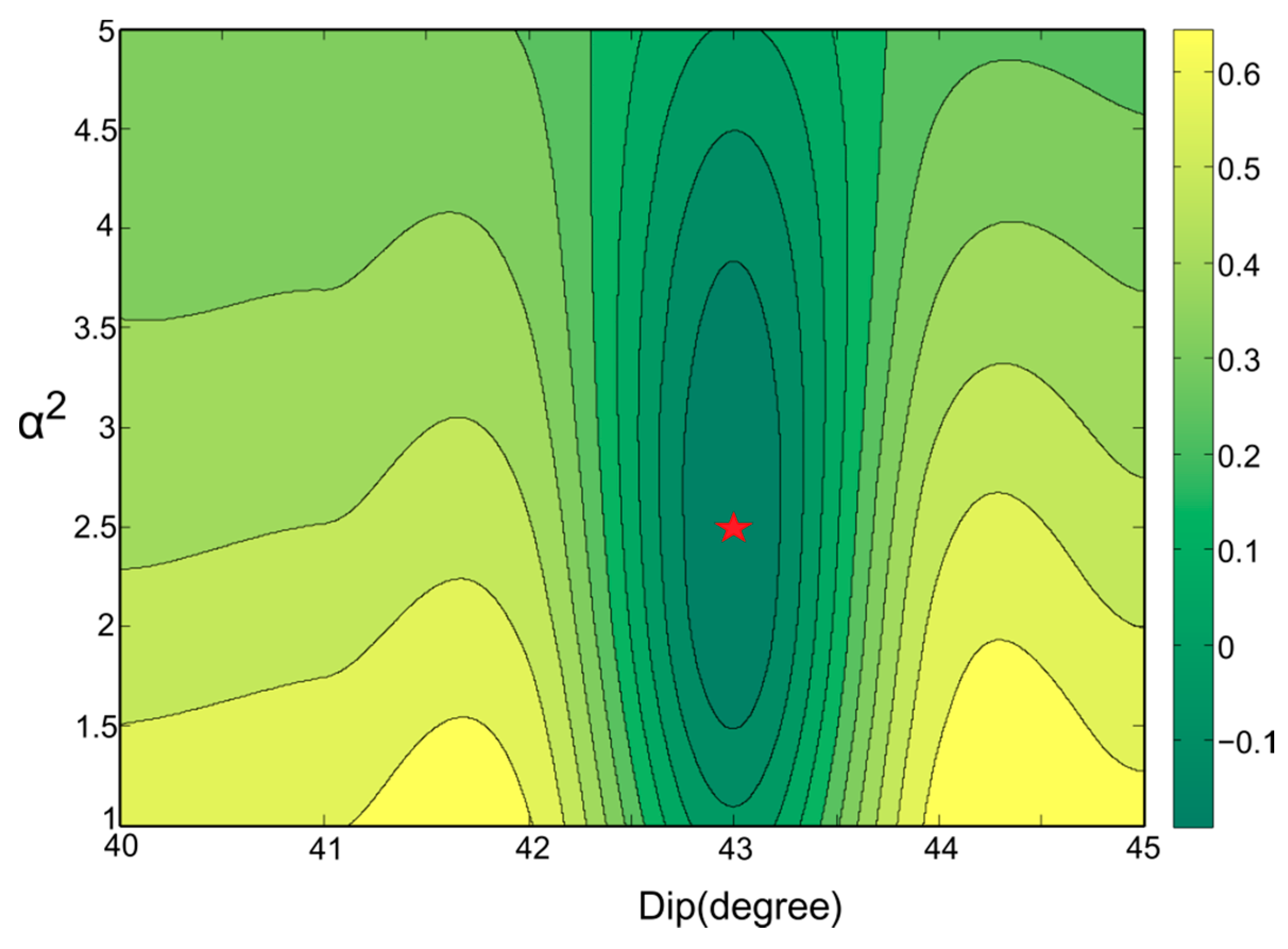
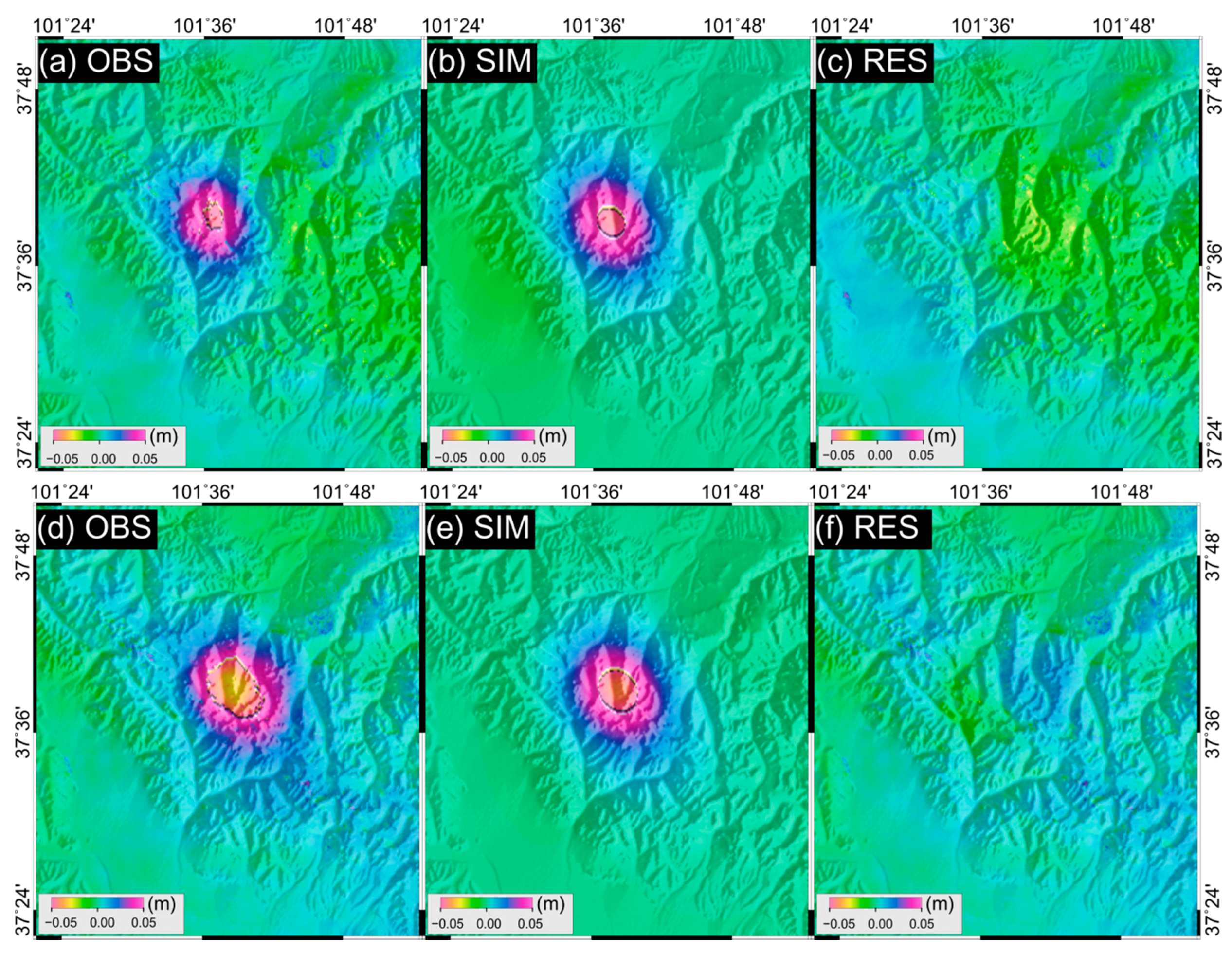
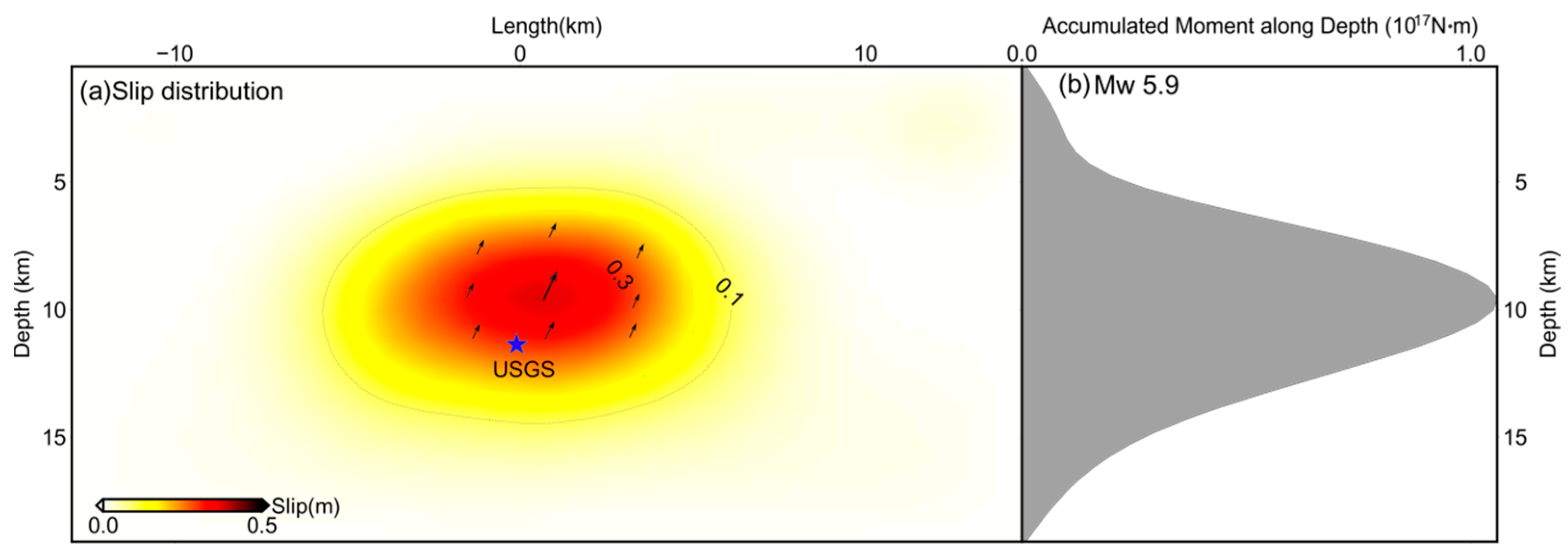
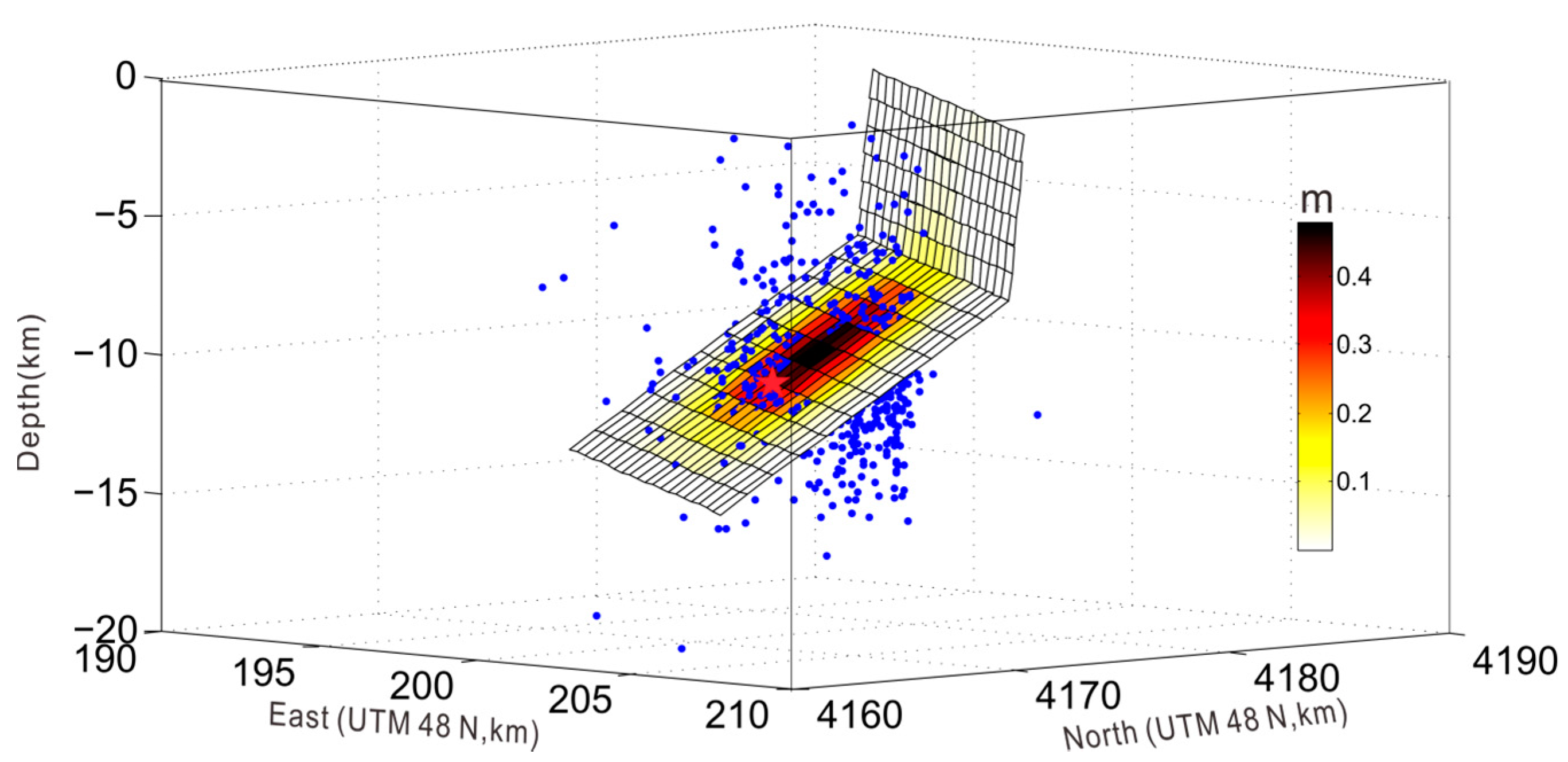
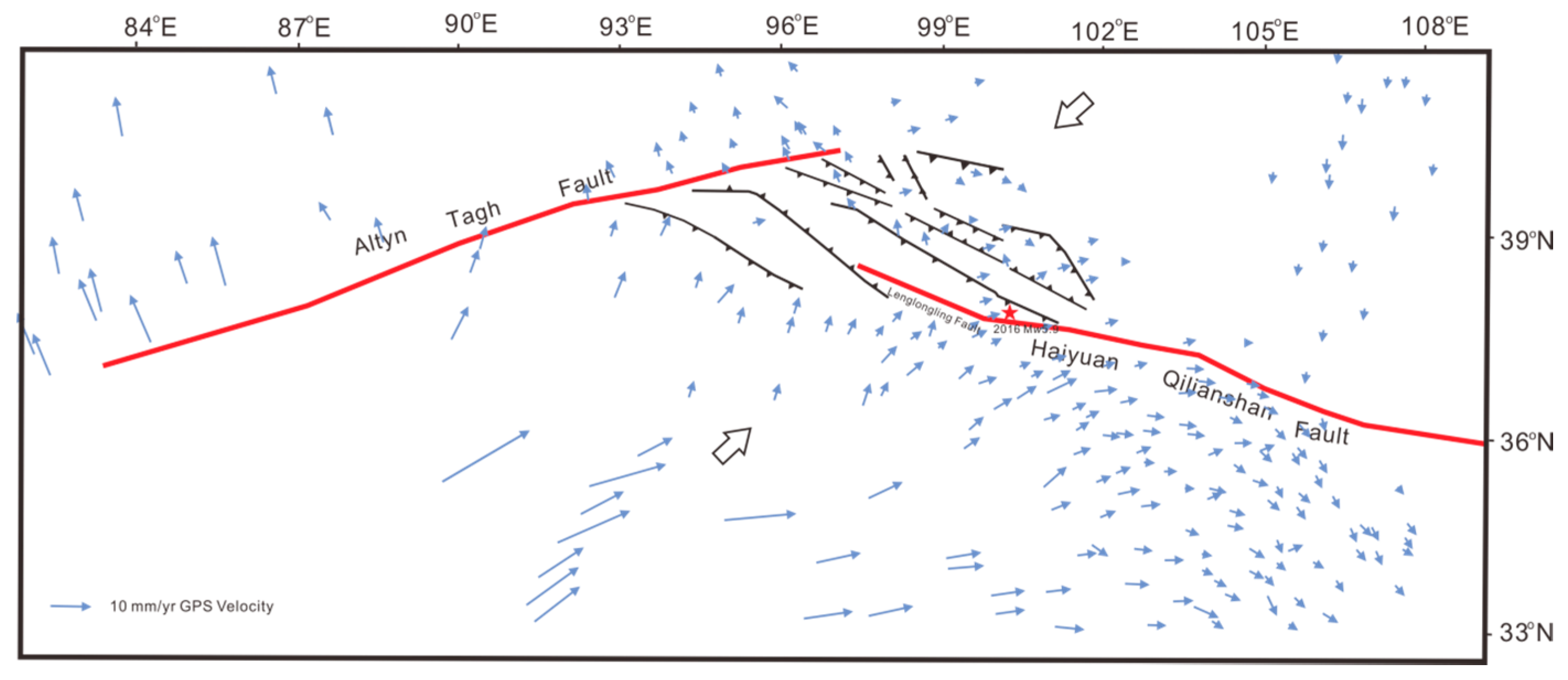
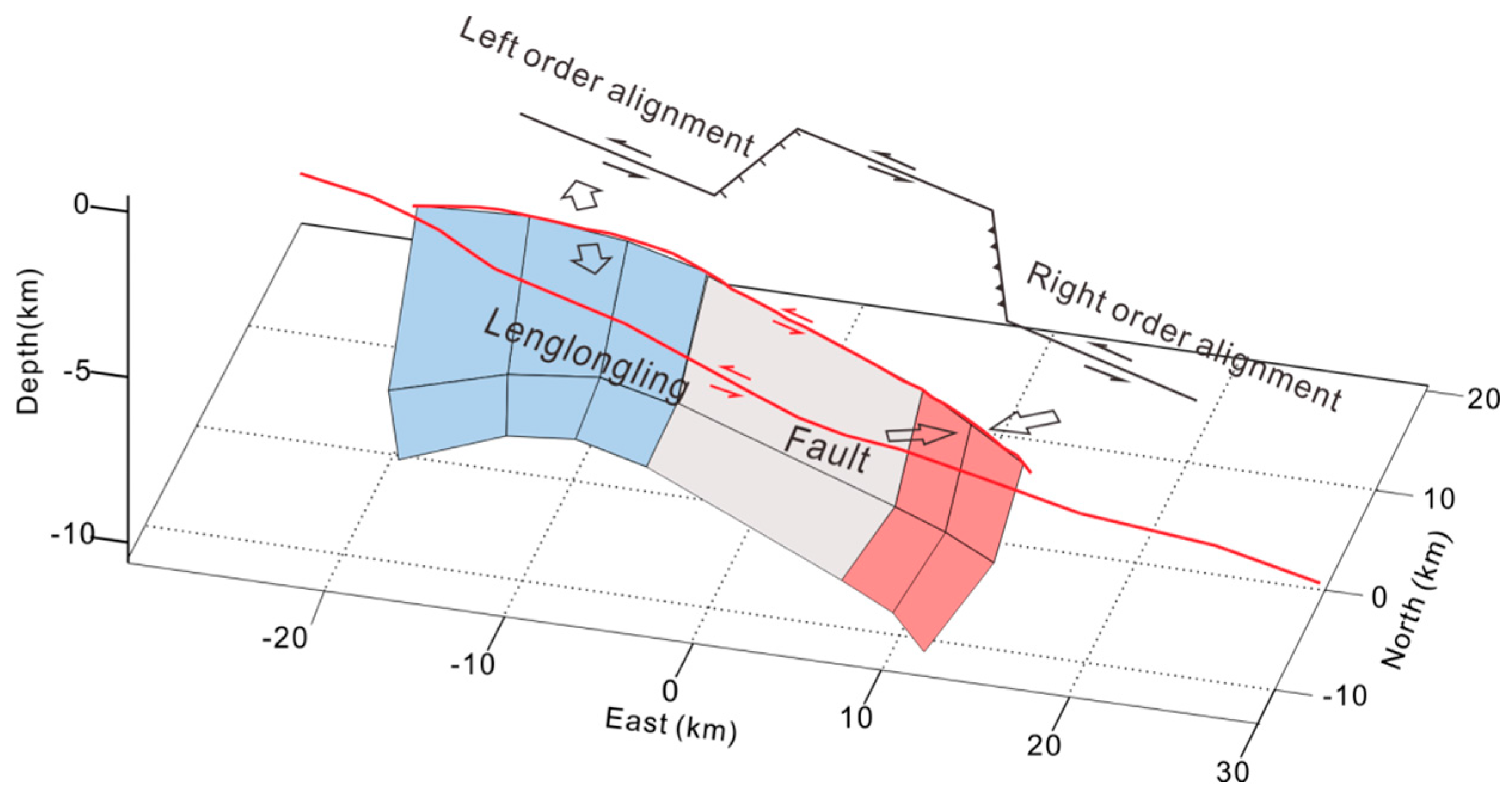
| No. | Acquisition Time | Path | Mode | Orbit | B⊥ | Incidence |
|---|---|---|---|---|---|---|
| Ifg1 | 20160113–20160206 | 128 | ScanSAR | Asc | 15 | 30°–46° |
| Ifg2 | 20160118–20160211 | 33 | ScanSAR | Des | 6.5 | 30°–46° |
| Source | Location | Epicenter Depth (km) | Focal Mechanisms | Fault Dimensions (km) | Magnitude | ||||
|---|---|---|---|---|---|---|---|---|---|
| Lon (°) | Lat (°) | Strike (°) | Dip (°) | Rake (°) | Length | Width | |||
| GCMT | 101.76 | 37.65 | 13.9 | 134 | 43 | 68 | - | - | 5.9 |
| USGS | 101.641 | 37.67 | 9.0 ± 1.6 | 134 | 43 | 68 | - | - | 5.9 |
| This study | 101.65 | 37.64 | 10.5 | 134 | 40 | 65 | 20 | 10 | 5.9 a |
| 101.65 | 37.64 | 10.5 | 134 | 43 | 68 | 24 | 20 | 5.9 b | |
© 2016 by the authors; licensee MDPI, Basel, Switzerland. This article is an open access article distributed under the terms and conditions of the Creative Commons Attribution (CC-BY) license (http://creativecommons.org/licenses/by/4.0/).
Share and Cite
Li, Y.; Jiang, W.; Zhang, J.; Luo, Y. Space Geodetic Observations and Modeling of 2016 Mw 5.9 Menyuan Earthquake: Implications on Seismogenic Tectonic Motion. Remote Sens. 2016, 8, 519. https://doi.org/10.3390/rs8060519
Li Y, Jiang W, Zhang J, Luo Y. Space Geodetic Observations and Modeling of 2016 Mw 5.9 Menyuan Earthquake: Implications on Seismogenic Tectonic Motion. Remote Sensing. 2016; 8(6):519. https://doi.org/10.3390/rs8060519
Chicago/Turabian StyleLi, Yongsheng, Wenliang Jiang, Jingfa Zhang, and Yi Luo. 2016. "Space Geodetic Observations and Modeling of 2016 Mw 5.9 Menyuan Earthquake: Implications on Seismogenic Tectonic Motion" Remote Sensing 8, no. 6: 519. https://doi.org/10.3390/rs8060519
APA StyleLi, Y., Jiang, W., Zhang, J., & Luo, Y. (2016). Space Geodetic Observations and Modeling of 2016 Mw 5.9 Menyuan Earthquake: Implications on Seismogenic Tectonic Motion. Remote Sensing, 8(6), 519. https://doi.org/10.3390/rs8060519







